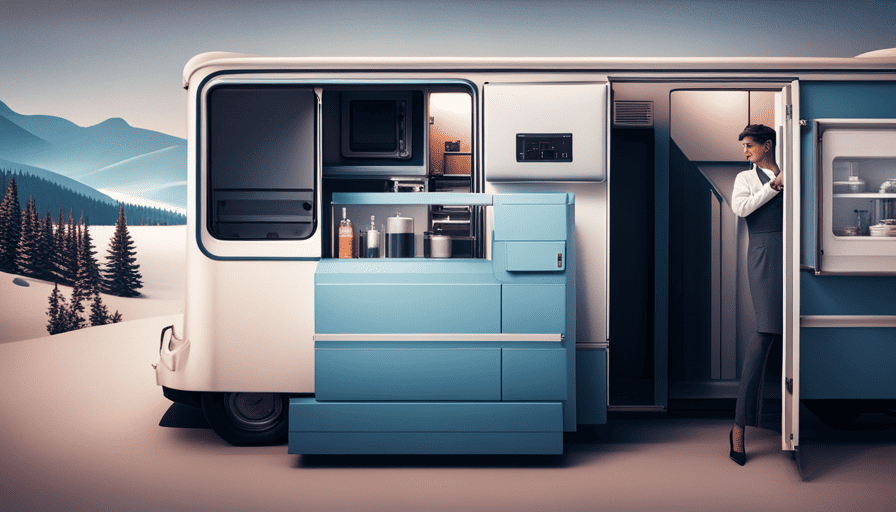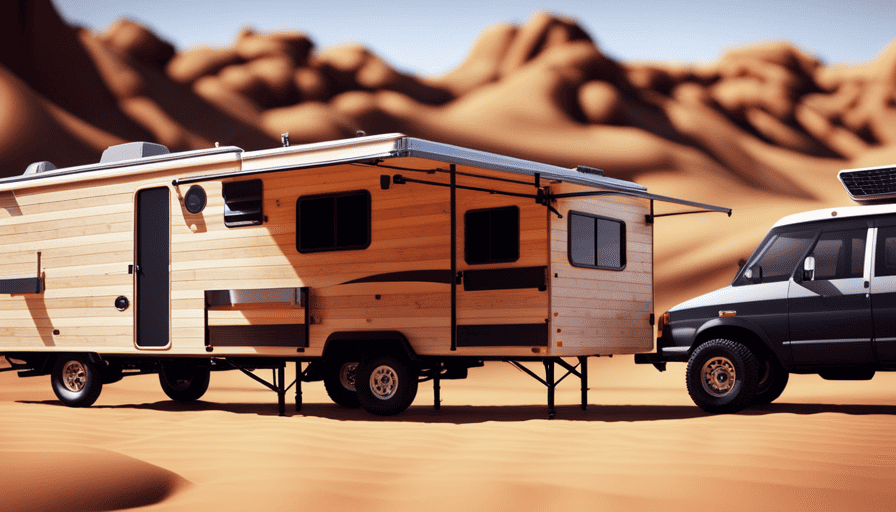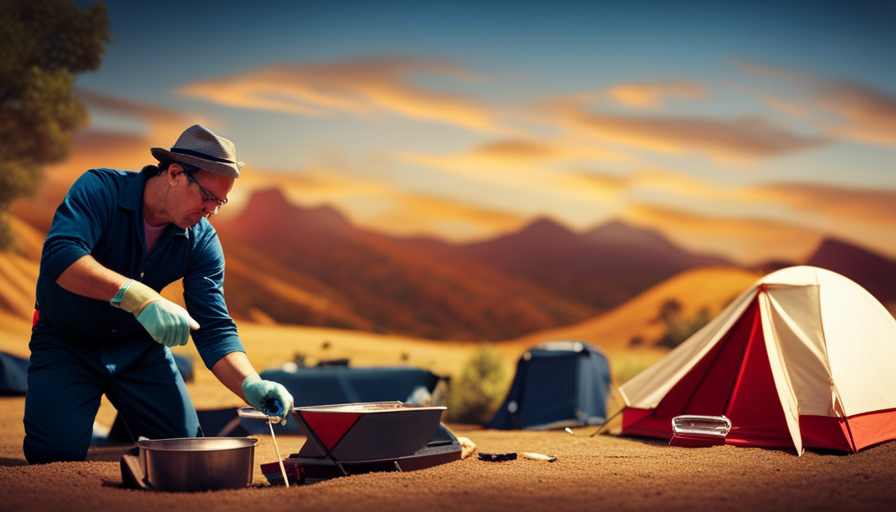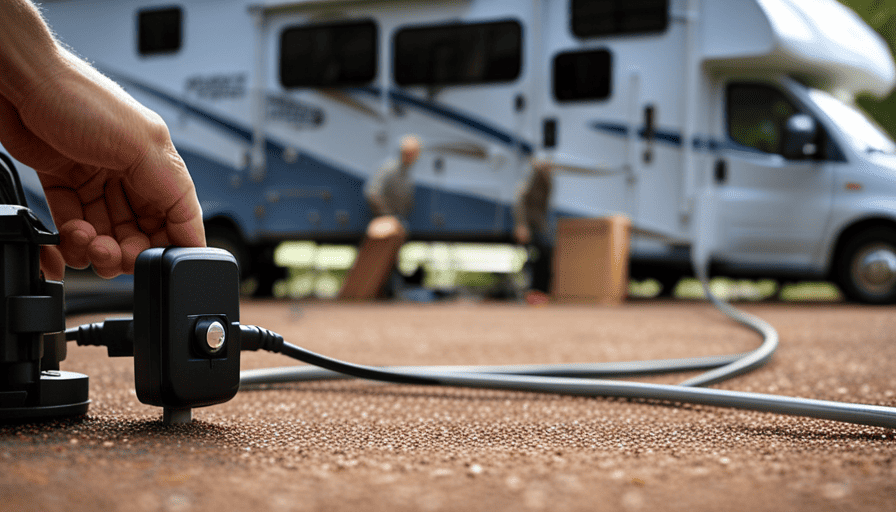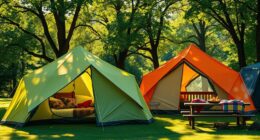Were you aware that more than 90% of people camping depend on refrigeration methods to preserve their food’s freshness while embarking on outdoor expeditions? Indeed, a refrigerator designed for camping is a crucial tool that enables those camping to keep perishable goods like meat, dairy, and vegetables fresh without having to use ice or a cooler.
But have you ever wondered how these compact refrigerators actually work? In this article, we will explore the intricate workings of a camper refrigerator and uncover the science behind its cooling process. From the basics of refrigeration to the different types of camper refrigerators available, we will delve into the inner workings of these portable appliances.
We will also discuss the various power sources, temperature control methods, and maintenance tips to ensure optimal performance. So, if you’re ready to unravel the mystery of how a camper refrigerator works, let’s dive right in!
Key Takeaways
- Camper refrigerators can be either absorption refrigerators or compressor refrigerators, with absorption refrigerators using heat, ammonia, and hydrogen gas for cooling, while compressor refrigerators use a compressor to compress and expand a refrigerant gas.
- The cooling process of a camper refrigerator involves the refrigerant being pressurized by a compressor, flowing through coils to lose heat and become a cooler liquid, passing through an expansion valve to rapidly expand and absorb heat, and then going through a cycle of evaporation, condensation, expansion, and compression to continuously cool the interior of the refrigerator.
- The thermostat in a camper refrigerator monitors and adjusts the cooling system, maintaining a consistent and safe temperature range of 34-40 degrees Fahrenheit.
- Proper food placement and storage solutions, such as using bins and organizers, help maximize space in a camper refrigerator and prevent food spoilage. Regular maintenance and cleaning of the refrigerator, including dusting coils, cleaning rubber seals, and checking the drain tube, are important for its longevity and performance.
The Basics of Refrigeration
So, you’re probably wondering how your camper refrigerator actually keeps your food nice and cold, huh? Well, let me break it down for you.
The basic principle behind camper refrigerators is the process of evaporative cooling. This is achieved through the use of a fluid called refrigerant, which undergoes a cycle of evaporation and condensation to create a cooling effect.
Inside the refrigerator, there is a compressor that pressurizes the refrigerant, causing it to turn into a hot, high-pressure gas. This gas then flows through a set of coils, where it loses heat and becomes a cooler, low-pressure liquid.
The liquid refrigerant then passes through an expansion valve, which causes it to rapidly expand and evaporate. This evaporation absorbs heat from the surroundings, which in turn cools down the interior of the refrigerator.
Another type of camper refrigerator that you might come across is the thermoelectric cooling system. This system uses the Peltier effect, which occurs when an electric current is passed through a junction between two different types of materials. One side of the junction becomes cold while the other side becomes hot. This temperature difference is used to cool the interior of the refrigerator.
Now that you understand the basics of refrigeration, let’s move on to the different types of camper refrigerators.
Types of Camper Refrigerators
To understand how a camper refrigerator functions, you’ll need to know the different types available.
There are two main types of camper refrigerators: absorption refrigerators and compressor refrigerators.
Absorption refrigerators use a combination of heat, ammonia, and hydrogen gas to create a cooling effect. The heat source can come from various power sources, such as electricity, propane, or even solar power. These refrigerators are known for their quiet operation and have no moving parts, making them more reliable and less prone to mechanical failure. They also offer a variety of storage options, including shelves, drawers, and door bins, to keep your food organized and easily accessible.
Compressor refrigerators, on the other hand, work similarly to the refrigerator in your home. They use a compressor to compress and then expand a refrigerant gas, which cools the interior of the refrigerator. These refrigerators are known for their energy efficiency and ability to cool rapidly. They also offer similar storage options as absorption refrigerators.
Understanding the different types of camper refrigerators will help you choose the best option for your needs.
Now, let’s delve into the various power sources that can be used to operate these refrigerators.
Power Sources
Using a combination of heat, ammonia, and hydrogen gas, absorption refrigerators create a cooling effect. These refrigerators can be powered by electricity, propane, or even solar power, making them a great option for campers who want alternative power sources.
When using electricity, the refrigerator simply plugs into a power source at the campsite. Propane-powered refrigerators utilize a small flame to heat the ammonia and hydrogen gas, creating the cooling effect. This allows campers to have refrigeration even when they are off-grid or without access to electricity. Additionally, some campers choose to install solar panels on their vehicles to power their camper refrigerators. This allows them to harness the power of the sun to keep their food and beverages cold. Solar power offers a sustainable and environmentally friendly option for camper refrigerators.
Transitioning into the next section about the cooling process, the power source activates the absorption process, which brings us to the next step: the cooling process.
Cooling Process
When it comes to understanding how a camper refrigerator works, it’s important to delve into the cooling process. This process involves four key points: evaporation, condensation, expansion, and compression.
Evaporation occurs when the refrigerant absorbs heat from the interior of the camper refrigerator, causing it to turn into a gas.
This gaseous refrigerant then moves to the condenser where it’s cooled and condensed back into a liquid state.
Next, the refrigerant undergoes expansion, which causes it to cool down even further.
Finally, the compressed refrigerant is sent back to the evaporator, where the cycle begins again.
Evaporation
Once the refrigerant absorbs heat from the inside of the camper refrigerator, it evaporates, following the principle of ‘out of sight, out of mind.’
This evaporation process plays a crucial role in creating the cooling effect inside the refrigerator. As the refrigerant evaporates, it changes from a liquid state to a gas state, absorbing energy from the surrounding environment, including the items inside the refrigerator. This absorption of heat causes the temperature inside the refrigerator to decrease, keeping the contents cool.
The evaporation process occurs in the evaporator coil, which is a set of tubes located at the back of the refrigerator. As the refrigerant evaporates, it moves to the next step of the cooling process – condensation – where it releases the heat it absorbed during evaporation.
Condensation
Condensation transforms the refrigerant from a gas back into a liquid, releasing the heat it absorbed and bringing a refreshing coolness to the contents of the refrigerator. To prevent condensation and maintain optimal humidity levels, camper refrigerators employ various techniques.
These include:
- Insulation: Thick insulation layers minimize temperature differences between the interior and exterior, reducing the likelihood of condensation forming on the refrigerator surfaces.
- Sealed compartments: The refrigerator is divided into separate compartments for storing different types of food. This helps regulate humidity levels and prevents moisture from spreading throughout the refrigerator.
- Humidity controls: Some camper refrigerators come equipped with humidity control settings, allowing users to adjust the moisture levels inside the refrigerator.
- Ventilation: Proper ventilation ensures air circulation, preventing excess moisture buildup and condensation.
- Drainage system: A built-in drainage system collects any condensation that forms and directs it outside the refrigerator.
Condensation and humidity control are vital aspects of camper refrigerators, ensuring the freshness and longevity of stored food.
In the subsequent section about expansion and compression, we will explore how the refrigerant undergoes further transformations to maintain the cooling effect.
Expansion and compression
After the condensation process, the next step in understanding how a camper refrigerator works is the expansion and compression cycle. This is a crucial part of the refrigeration system that allows for the cooling effect.
The expansion process involves the refrigerant passing through a small valve, causing it to rapidly expand. As a result, the refrigerant becomes colder and changes from a high-pressure liquid to a low-pressure gas. This cold gas then flows into the evaporator coils inside the refrigerator, where it absorbs heat from the food and drinks stored inside.
Once the gas has absorbed heat and warmed up, it enters the compression cycle. This cycle involves the gas being compressed by a compressor, which increases its pressure and temperature. The hot, high-pressure gas then flows through the condenser coils located at the back of the refrigerator. As it passes through the condenser coils, the gas releases heat to the surrounding environment and returns to its liquid state.
With the expansion and compression process complete, the refrigerant is ready to repeat the cycle and continue cooling the refrigerator. Now, let’s move on to the next section about temperature control and how it plays a vital role in keeping your food fresh.
Temperature Control
To maintain the desired temperature, a camper refrigerator uses a thermostat that constantly monitors and adjusts the cooling system. This temperature control mechanism is crucial to ensure that the food and beverages stored inside remain fresh and safe for consumption.
The average temperature range for a camper refrigerator typically falls between 34 and 40 degrees Fahrenheit, which is considered ideal for preserving perishable items.
The thermostat in a camper refrigerator works by sensing the temperature inside the unit and activating the cooling system as needed. When the temperature rises above the desired range, the thermostat signals the compressor to start working, which then compresses the refrigerant gas. As the gas is compressed, it releases heat, causing it to cool down. This cooled gas is then circulated through the refrigerator’s evaporator coils, where it absorbs heat from the interior compartment, lowering the temperature.
Not only does the thermostat control the temperature, but it also plays a vital role in maintaining energy efficiency. By constantly monitoring the temperature and adjusting the cooling system accordingly, the refrigerator can optimize its energy consumption. This helps to ensure that it operates efficiently and minimizes power usage, making it suitable for use in a camper where energy resources may be limited.
With the temperature control system in place, the camper refrigerator can effectively maintain a consistent and safe temperature range for storing food and beverages. This is crucial for ensuring the longevity and quality of the items inside.
Moving on to storage and organization, let’s explore how the refrigerator is designed to maximize space and convenience.
Storage and Organization
When it comes to storage and organization in a camper refrigerator, there are three key points that need to be considered. The first is maximizing space, which involves using the available space efficiently and utilizing storage solutions such as bins and organizers.
The second is proper food placement, which involves placing items in the refrigerator in a way that allows for proper air circulation and prevents cross-contamination.
Lastly, preventing food spoilage is crucial, and can be achieved by regularly checking expiration dates, keeping track of perishable items, and maintaining the refrigerator at the correct temperature.
Maximizing space
One way to optimize the limited space in a camper refrigerator is by organizing items strategically. This can be achieved by using storage solutions specifically designed for compact appliances. There are various options available, such as stackable containers, adjustable shelves, and door-mounted organizers.
Stackable containers help maximize vertical space, allowing for efficient storage of items like fruits, vegetables, and condiments. Adjustable shelves allow for customization based on the size and shape of different food items. Door-mounted organizers are perfect for storing small items like jars and bottles, freeing up valuable shelf space.
By utilizing these storage solutions, you can make the most of the limited space in your camper refrigerator and ensure that everything is easily accessible. Proper food placement is another important aspect of optimizing space and will be discussed in the next section.
Proper food placement
Make sure you know the best way to strategically place your food in order to maximize the limited space and keep everything easily accessible. Here are three key points to consider when organizing your camper refrigerator:
-
Food Rotation: To ensure that your food stays fresh, it’s crucial to practice proper food rotation. Place newer items behind older ones, so that the older items are used first. This will prevent spoilage and reduce waste.
-
Preventing Cross Contamination: To maintain food safety, separate raw meats from other food items. Store them in sealed containers or plastic bags to prevent any potential leakage. Additionally, keep fruits and vegetables separate from raw meats to avoid cross-contamination.
-
Utilize Containers and Organizers: Use containers and organizers to maximize space and keep similar items together. This will make it easier to locate specific items and prevent them from getting lost or forgotten.
By following these guidelines for proper food placement, you can ensure that your camper refrigerator is organized and efficient in preventing food spoilage.
Preventing food spoilage
To ensure your food stays fresh and delicious, it’s vital to prevent food spoilage by taking proactive measures. Proper food storage is key in preventing spoilage.
When stocking your camper refrigerator, make sure to arrange items in a way that allows for proper air circulation. This will help maintain a consistent temperature and prevent certain foods from spoiling more quickly than others.
Additionally, it’s important to keep perishable foods at the right temperature. Set your refrigerator to the recommended temperature of 40°F (4°C) or below to slow down bacterial growth. Be sure to check and adjust the temperature regularly.
Lastly, be mindful of expiration dates and rotate your food supply to ensure older items are used first. By following these guidelines, you can prevent food spoilage and keep your meals fresh during your camping adventures.
Speaking of maintenance and cleaning, let’s move on to the next section.
Maintenance and Cleaning
Keep your camper refrigerator running smoothly by regularly scrubbing away any built-up grime and gunk, like a refreshing spring rain washing away winter’s dirt and debris. Here are some maintenance tips and cleaning products that’ll ensure your refrigerator stays in top-notch condition:
-
Use a mild detergent: When cleaning the interior of your camper refrigerator, avoid using harsh chemicals that can damage the surfaces. Instead, opt for a mild detergent mixed with warm water to gently remove any stains or spills.
-
Clean the seals: The rubber seals around the refrigerator door can accumulate dirt and grime over time, compromising their effectiveness. To keep them in good shape, wipe them down regularly with a solution of mild soap and water, making sure to dry them thoroughly afterward.
-
Dust the coils: The refrigerator’s coils are responsible for cooling the unit, and they can collect dust and debris, hindering their performance. Use a soft brush or vacuum cleaner with a brush attachment to gently remove any dirt from the coils.
-
Check the drain tube: The drain tube allows excess water to escape from the refrigerator. Ensure it’s clear of any obstructions by flushing it with a mixture of warm water and vinegar.
Regular maintenance and cleaning will help extend the lifespan of your camper refrigerator and prevent potential issues. Speaking of issues, let’s move on to troubleshooting…
Troubleshooting
When it comes to troubleshooting camper refrigerators, there are a few common issues that can arise and their corresponding solutions.
These include problems with temperature control, leaks, and strange noises.
In addition, knowing how to deal with power outages and seeking professional help when needed are important aspects of troubleshooting camper refrigerators.
Common issues and solutions
One common issue with camper refrigerators is that they may not cool properly, but this can often be solved by cleaning the condenser coils. The common causes for this issue include dust and debris accumulating on the coils, which prevents them from releasing heat efficiently.
To troubleshoot this problem, start by disconnecting the refrigerator from the power source. Then, locate the condenser coils, which are usually located on the back or bottom of the refrigerator. Use a vacuum cleaner or a soft brush to remove any dirt or debris from the coils.
After cleaning, reconnect the refrigerator to the power source and check if it cools properly. If the issue persists, it may be necessary to seek professional help.
Dealing with power outages is another important aspect of maintaining a camper refrigerator’s functionality.
Dealing with power outages
To ensure your camper fridge stays running during power outages, it’s important to have a backup power source such as a generator or solar panels. Consider that, on average, a camper refrigerator uses around 100 watts of power per hour. So, having a reliable power backup can help prevent food spoilage and maintain your camping experience.
When preparing food in your camper, it’s crucial to have a power backup plan in place. Generators are a popular choice as they provide a consistent source of electricity. Solar panels are another alternative power source that can harness energy from the sun to keep your fridge running. These panels convert sunlight into usable electricity, allowing you to store food without relying on traditional power sources.
When seeking professional help, it’s important to consult with a certified technician who specializes in camper refrigerator repairs and maintenance.
Seeking professional help
If you’re experiencing issues with your camper fridge, don’t hesitate to reach out to a certified technician for professional help. Seeking professional guidance is crucial when dealing with complex refrigeration systems, as experts can provide accurate diagnosis and offer appropriate solutions. They possess the necessary knowledge and experience to identify and resolve any problems that may arise.
To emphasize the significance of professional advice, consider the following table:
| Issue | Possible Cause | Solution |
|---|---|---|
| Fridge not cooling | Faulty compressor | Replace compressor |
| Strange noises | Loose or damaged fan motor | Repair or replace fan motor |
| Leaking water | Clogged drainage system | Clear drainage system |
| Fridge freezing | Defective temperature control | Adjust temperature control settings |
| Inconsistent cooling | Damaged door gasket or seal | Replace gasket or seal |
Remember, seeking expert advice ensures that your camper fridge operates efficiently and reliably. Transitioning into the subsequent section about ‘tips for efficient use,’ let’s explore some techniques to maximize the performance of your camper fridge.
Tips for Efficient Use
Before loading my camper refrigerator, I always make sure to pre-cool it. This helps to maintain the internal temperature and ensures that the food stays fresh for longer periods of time.
Additionally, I make it a point to keep the door closed as much as possible to prevent any cold air from escaping.
Lastly, I use insulation materials such as foam or reflective blankets to further enhance the refrigerator’s efficiency and keep the interior cool.
By following these tips, I’m able to maximize the efficiency of my camper refrigerator and ensure that my food stays cold and safe during my camping trips.
Pre-cooling before loading
When getting ready to pack your camper fridge, it’s essential to pre-cool it to ensure all your food stays fresh and cool throughout your trip. Pre-cooling your camper fridge has numerous benefits and can be done using various techniques.
Here are some pre-cooling techniques you can try:
- Turn on the fridge at least 24 hours before loading it with food.
- Set the temperature to the coldest setting to create an ideal cooling environment.
- Place a few ice packs or frozen water bottles inside the fridge to speed up the cooling process.
- Keep the fridge empty during pre-cooling to allow for maximum airflow and efficient cooling.
- Check the temperature regularly to ensure it reaches the desired level before loading your food.
By pre-cooling your camper fridge properly, you can optimize its cooling capacity and ensure your food remains fresh and safe throughout your trip.
Now, let’s move on to the next step of keeping the door closed to maintain the ideal temperature inside the fridge.
Keeping the door closed
Before I move on to the current subtopic, let me briefly touch on the importance of pre-cooling before loading your camper refrigerator. This step is crucial to ensure that your refrigerator reaches the desired temperature quickly and efficiently. Now, let’s dive into the current subtopic: keeping the door closed. By maintaining a closed door, you are effectively keeping the cold air inside and preventing warm air from entering. This is essential for keeping your food fresh and preventing odors from seeping into other items. To emphasize the significance of this practice, let me present a table that highlights the potential consequences of not keeping the refrigerator door closed.
| Consequence | Explanation |
|---|---|
| Food spoilage | Exposing food to warm air can lead to spoilage, impacting its taste and safety. |
| Increased energy usage | Frequent opening of the door forces the refrigerator to work harder, consuming more energy. |
| Odor contamination | Leaving the door open allows odors from different food items to mix and linger in the fridge. |
Now that we understand the importance of keeping the door closed, let’s explore the next step: using insulation materials.
Using insulation materials
To ensure your food stays fresh and your energy usage remains efficient, it’s time to explore how you can use insulation materials in your camper refrigerator.
Insulation materials play a crucial role in maintaining the desired temperature inside the refrigerator and preventing heat exchange with the outside environment. By selecting the right insulation materials, you can significantly improve the energy efficiency of your camper refrigerator.
Commonly used insulation materials include foam, fiberglass, and reflective insulation. Foam insulation is lightweight and offers excellent thermal resistance, while fiberglass insulation provides superior heat insulation properties. Reflective insulation helps to reflect radiant heat away from the refrigerator.
By properly insulating your camper refrigerator, you can minimize energy loss and reduce the strain on your refrigerator’s cooling system. This will not only keep your food fresh but also save you money on energy costs.
Now let’s delve into the important safety considerations when using a camper refrigerator.
Safety Considerations
One must always be mindful of safety considerations when operating a camper refrigerator. This is especially important when it comes to food safety and electrical safety. Proper handling and storage of food items is crucial to prevent contamination and foodborne illnesses. It is essential to keep the refrigerator clean and organized, with separate compartments for different types of food, such as raw meat and vegetables. This helps to avoid cross-contamination and maintain the freshness of the food.
Regularly checking the temperature inside the refrigerator is also vital to ensure that it’s operating at the correct level to keep the food at a safe temperature.
In terms of electrical safety, it’s important to follow all manufacturer instructions and guidelines for the camper refrigerator. This includes properly grounding the refrigerator and ensuring that it’s connected to a reliable power source. Regularly inspecting the electrical components, such as cords and plugs, for any signs of damage is also essential for safe operation.
Additionally, it’s important to be cautious of any potential electrical hazards, such as water near the refrigerator or overloading the electrical system of the camper. By following these safety considerations, one can enjoy the convenience of a camper refrigerator while ensuring the safety of both the food and the electrical system.
Frequently Asked Questions
How much power does a camper refrigerator typically consume?
A camper refrigerator typically consumes around 100-200 watts of power, depending on the size and energy efficiency of the unit. Energy efficiency is a crucial factor in minimizing power consumption. These refrigerators use a combination of techniques to cool and preserve food, such as compression and evaporation. By efficiently managing power consumption, camper refrigerators ensure that you can enjoy your camping trip without worrying about draining your power source.
Can a camper refrigerator be used while the vehicle is in motion?
Yes, a camper refrigerator can be safely used while the vehicle is in motion. There are several advantages to using a camper refrigerator while traveling. Firstly, it allows you to keep your perishable food items fresh and prevents them from spoiling. This ensures that you have access to nutritious meals throughout your journey. Additionally, using a camper refrigerator eliminates the need to rely on external sources for food storage, providing you with convenience and independence during your travels.
Are camper refrigerators able to run on solar power?
Using solar power to run a camper refrigerator is like harnessing the sun’s energy to keep your food cold on the go. It’s a smart choice for off-grid living.
Camper refrigerators designed for solar power efficiency use photovoltaic panels to convert sunlight into electricity. This energy is stored in a battery, which powers the refrigerator’s compressor, keeping your food fresh even when you’re away from traditional power sources. It’s a sustainable and convenient option for those seeking to live off the grid.
Are camper refrigerators prone to leaking or condensation issues?
Camper refrigerators are designed to prevent leaks and condensation issues. They are equipped with tight seals around the doors and compartments to prevent leaks. Additionally, they have a drainage system that collects any water and channels it outside the camper.
To prevent condensation, camper refrigerators are insulated to maintain a consistent temperature inside. This insulation reduces the formation of moisture on the walls and surfaces. These features ensure that camper refrigerators operate efficiently and without any leaking or condensation problems.
Can a camper refrigerator be used in extreme temperatures, such as during winter camping?
Yes, a camper refrigerator can be used during winter camping. To withstand extreme temperatures, camper refrigerators are equipped with insulation methods such as thick foam insulation and double-pane glass doors. These features help to maintain a consistent internal temperature and prevent heat loss. Additionally, some camper refrigerators include a winter mode that adjusts the cooling system to function optimally in colder temperatures. This ensures that the refrigerator operates efficiently and keeps food and beverages properly chilled even in freezing conditions.
Conclusion
In conclusion, understanding how a camper refrigerator works is essential for any outdoor enthusiast. Just like a conductor orchestrating a symphony, the cooling process plays a vital role in keeping your food fresh and your drinks chilled, even in the scorching heat.
With various power sources and temperature control options, it ensures the optimal preservation of your perishables. Regular maintenance and cleaning are necessary to keep it running smoothly, while troubleshooting techniques can save you from any unexpected glitches.
So, treat your camper refrigerator like a loyal companion on your adventures, and it won’t ever disappoint.

